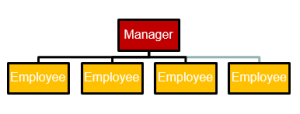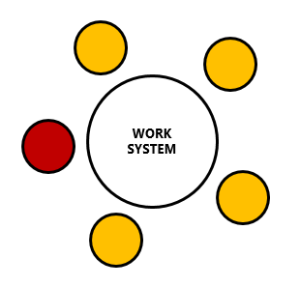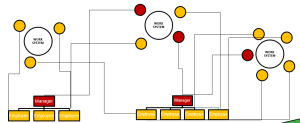Circle Work: achieving cross-functional customer focus
A TEAM OF OWNERS
Ask any group of people to draw their ‘org chart’, and they’re going to draw something like this:
There is nothing wrong with this – it’s a useful diagram that shows managerial relationships – who is accountable for which teams. This has value simply because if a given team is doing great, or not so great, it’s convenient to know who to talk to. And we can have meetings of five teams by coordinating five calendars instead of forty.
Here’s the thing though – this visual representation becomes the dominant mental model for how we think about work. Notice how it implies four separate people, only connected through one other who sits ‘over’ them. It’s not a big leap from here to see how relationships of dominance and dependence can emerge, with the friendly version being the ‘caretaking’ manager, the not-so-nice version being the autocratic manager. Either way felt ownership of the work is gathered in just the one person. Not nice if you’re that person.
(Click here for a pdf version of this post)
So here’s a change. Draw your team like this….
…as a Circle, that gathers around the work of the team – it’s mission. But notice a key feature – we still have a managerial leadership role. And we define that role very deliberately – as the role that takes accountability for the team delivering it’s mission. So it has the authority to convene meetings, to name the conversation that needs to be had, and, when required, to make decisions if the team can’t naturally find a consensus that makes sense.
The managerial role is given formal accountability by the organisation, but an effective managerial leader knows this, but does not keep that accountability all for themselves. By the person in that role treating the others in the team like they are co-owners, like they are all partners in business together, ownership of the team becomes shared. And like in a legal partnership, not everyone necessarily owns the same share – in this case, the manager is the 51% shareholder, so, when required, it’s their call.
Adopting this mental model, the practices of co-ownership, is a key element to gaining one of the benefits of hierarchy while removing the major negative – the feeling that only one person wears the burden. And given that most people are originally wired to want to make a difference, this quickly leads to a more accountable and creative team.
But this is just the first stage. The real wins come next, when we bring customers into the mix.
NOW FOCUS ON CUSTOMERS
Has there even been an advertisement that says;
‘Our org chart builds effective cars’
Customers don’t care about the internal org design. What they care about is having their need met, with the particular characteristics that create the value they are expecting. And the job of designing and operating an enterprise is to set things up so the work is figuring out better ways to deliver for the customer. Sadly, much of the work inside enterprises is a sophisticated version of ‘me first’.
Current trends in organisational design decree hierarchies as bad, and networks /self-organising teams as good. The word ‘agile’ usually gets thrown into the mix for good measure too. And…the concepts are sound! The more we can organise around the end-to-end processes that deliver value to particular customer groups, the less seams are going to trip us up. This is not new, various ‘councils’, ‘user groups’, ‘cross-functional teams’ and the like have been set up with the best of intentions.
But then it gets messy. And it doesn’t work. Here’s four (non-exhaustive) reasons as to why the cross-functional thing struggles.
1) The mental model of the org chart is hard to overcome. Like a gravitational field, people are naturally pulled back toward their ‘home team’, which will consist of somewhat like-minded people who share common beliefs. This is what feels ‘real’, and the artefact of the org chart itself proves it. And consider the names given to the cross-functional groups designed to focus on the end-to-end – ‘council‘, ‘stakeholder groups’ – none of these feel solid.
2) The meetings don’t work. People eventually won’t go to things that waste their time. For a group to work on an end-to-end process, the minimal requirements are a way to see how well the end-to-end process is going in terms of delivering what it’s there for, and a willingness to study the process to first understand it, then work on it. Without these in place, meetings will naturally become first an ideas-fest, then a disappointment-fest as all ideas seem great, therefore none do. Visibility on how the process is going allows the group to look together at the information, rather than at each other with blame.
3) Missing people. For any system to improve, it needs the people in the room who have the authority, power and influence to make change. This includes the capability to ‘see the whole board’, as well as having those that represent ‘the whole board’ present. Whenever a group has to go elsewhere for approval to propose an initiative….initiative is lost.
4) No contextual support to get ideas into action. Many groups can arrive at solutions that would make a significant difference…only to find out that they are like the weird kids in the corner trying to get the adults to pay attention. Interest in the group nosedives directly after that. And the cynicism muscle strengthens.
CIRCLES
So what’s a better way to set things up? First, we choose a different word for a team. Borrowing from Sociocracy, we often suggest ‘Circle‘ to be the term as it creates a difference from the traditional home-base team, gets people’s attention, and creates the mental picture of ‘everyone in’. Then we make the purpose of the Circle clear – in the case of an end-to-end process, the purpose is along the lines of ‘to continually improve the customer experience, cost and sustainability of the work system’.
Here’s where the key point comes in – using the home-base hierarchy structure, a leader of the Circle is appointed, and is asked to take accountability for the Purpose of the Circle as part of their role. This leader is explicitly given the authority name the people they need in the Circle (those with authority, power or influence to make a difference to it), and those people are invited to join. Where they come from the same business area as the Circle Leader, any issues in attending can be resolved easily. And where they are from a different business area, this is explicitly discussed with that area, it’s not just left to the wind.
In other words, we clarify or modify roles so taking co-ownership of the Circle being successful becomes part of people’s roles….whichever home-base department they come from.
Without waiting for Circle membership to be perfect (it changes over time anyway), the first Circle meeting is kicked-off. This is where the customers of the Circle are established, what they value, and all currently available measures to see how we’re doing to deliver that value are tabled. The group works over the first sessions to establish an initial iteration of their ‘telemetry wall’, which creates the central point of discussion each week. The goal then becomes simple (but not easy) – to reduce the variability of the customer experience and to raise the value of the customer experience. Ideas are table, triaged, tried, then the measures are viewed each week like a sport team looking at the scoreboard to see if their changes are having an effect.
If a group of people gathers together weekly and can look at meaningful information about their work, it’s not possible to stop them trying to make it better.
WHAT ABOUT THE HIERARCHY?
How do the Circles fit with the home-base hierarchy? Each home-base team performs a role in a variety of end-to-end processes. You can look at them like large, complex machines in a production line that produces a variety of products. It’s the job of those within each home-base unit to design and run their areas so what is required of them by each Circle is delivered.
Seems obvious. And you may think this is already happening. But in the absence of any information about what the overall process needs (which comes from the Circles), the best any well-meaning area can do is optimise its own situation. This is what the Circles change.
This is a key point. We are changing the goal of each area from ‘deliver your KPI’s in isolation to ‘deliver what is required of you by the Circles you are a part of’. In other words, we are making sure that what is being optimised is the end-to-end process, and not the results of any one component of it. And because cost can only be taken out at a local level, there is always a role for each area to see how it can deliver what’s required of it with less resource.
HOW DO WE GOVERN ALL OF THIS?
With multiple Circles up and running, along with project work, coordination is going to be required. This is where the Governance Circle comes in. Using the home-base hierarchy, this is a weekly gathering of the most senior role in the unit and the two organisational levels below them (yes, two – so this meeting can be 25 people!). The purpose of this gathering, this Circle, is as the name suggests – governance[1].
How does it work? Each week, the ‘current reality’ is checked, which is a rapid go-through of financial indicators, customer experience (from the Circles), staff engagement, and status of the three ‘active’ projects (yes, three, but that’s for another time). Then, agenda items are called for, triaged, and processed so any conflicts requiring clarity, discussion or a decision are raised and dealt with. And by having the most senior person in the room – if the group can’t find a consensus solution (or if the consensus solution doesn’t add up), a decision is made and we move on. No waiting.
This works. But it’s not the practical aspects of the Governance Circle that cause the most change. It’s the cultural effect of having the whole group gather weekly, to review information about the whole area, and to then have the ability to listen, discuss and learn from each other. In a surprisingly short amount of time, ‘local’ thinking starts to give way to ‘global’, understanding is reached about the capacity of certain key areas to deliver, and help is provided.
All simply because people, when given information about something bigger and an avenue to make a difference….will generally do so.
SUMMARY
We have a Governance Circle which oversees the work of the whole area and resolves conflicts. We set up Circles around the end-to-end customer processes to provide a forum for improvement, using the home-base hierarchy to create the accountability and authority required so each Circle can be effective. Each home-base hierarchy ‘team’ or ‘unit’ then focuses on doing its part for each Circle it’s a part of, rather than ‘achieving our KPI’s’, and at the same time looks to reduce the resource required in doing so.
The best part of the above? It bring large groups together and joins them together in the mission that they were always on. And being connected makes for better days at work.
(If you would like a pdf version of this post, click here)
[1] This in sociocratic terms is called double linking and works upwards and downwards in the circles.



